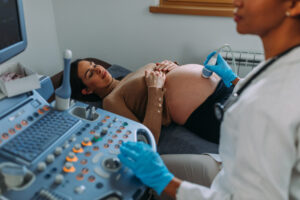Learning objectives
- Describe the differences in anatomy and physiology between pediatric patients and adults
- Understand how these differences impact anesthesia practice in pediatric patients
Background
- Pediatric patients include the following groups
- Neonates: A baby within 44 weeks of age from the date of conception
- Infants: Up to 12 months of age
- Children: 1-12 years
- Adolescents: 13-16 years
- The differences between pediatric and adult anesthetic practice are reduced as patients become older
Anatomy and physiology
Airway and respiratory system
- Large head, short neck, and prominent occiput
- The tongue is relatively large
- The larynx is high and anterior (C3-C4 level)
- Epiglottis is long, stiff, and U-shaped → flops anteriorly → head needs to be in the neutral position to visualize it
- Neonates breathe through their nose → narrow nasal passages are easily blocked by secretions and may be damaged by a nasogastric tube or nasally placed endotracheal tube (ETT)
- 50% of airway resistance comes from the nasal passages
- The airway is funnel-shaped and narrowest at the level of the cricoid cartilage
- Trauma to the airway results in edema
- 1 mm of edema can narrow a baby’s airway by 60%
- Presence of a leak around the ETT to prevent trauma resulting in subglottic edema and subsequent post-extubation stridor
- ETT must be inserted to the correct length to sit at least 1 cm above the tracheal carina and taped securely to prevent tube dislodgement with head movement
- Neonates and infants have a limited respiratory reserve
- Horizontal ribs prevent the “bucket handle” action seen in adult breathing and limit an increase in tidal volume (TV)
- Ventilation is primarily diaphragmatic
- Bulky abdominal organs or a stomach filled with gases from poor bag-mask ventilation can impinge on the contents of the chest and splint the diaphragm, reducing the ability to ventilate adequately
- The chest wall is more compliant → functional residual capacity (FRC) is relatively low
- FRC decreases with apnea and anesthesia, causing lung collapse
- Minute ventilation is rate-dependent as there are little means to increase TV
- Closing volume is larger than FRC until 6-8 years → increased tendency for airway closure at end-expiration → neonates and infants need intermittent positive-pressure ventilation (IPPV) during anesthesia and benefit from a higher respiratory rate (RR) and use of PEEP
- Continuous positive airway pressure (CPAP) during spontaneous ventilation improves oxygenation and decreases the work of breathing
- Work of respiration may be 15% of oxygen consumption
- Muscles of ventilation are easily subject to fatigue due to the low percentage of type I muscle fibers in the diaphragm → number increases to the adult level over the first year of life
- Alveoli are thick-walled at birth → only 10% of the total number of alveoli found in adults → alveoli clusters develop over the first 8 years of life
- Apnea is common postoperatively in premature infants → associated with desaturation and bradycardia
- RR = 24 – age/2
- Spontaneous ventilation TV = 6-8 mL/kg; IPPV TV = 7-10 mL/kg
- Physiological dead space = 30% and increased by anesthetic equipment
Cardiovascular system
- The myocardium is less contractile in neonates, causing the ventricles to be less compliant and less able to generate tension during contraction → limits the size of the stroke volume → cardiac output is rate-dependent
- The infant behaves with a fixed cardiac output state
- The vagal parasympathetic tone is predominant, making neonates and infants more prone to bradycardia
- Bradycardia is associated with reduced cardiac output
- Treat bradycardia associated with hypoxia with oxygen and ventilation
- External cardiac compression is required in neonates with a heart rate of ≤60 bpm or 60-80 bpm with adequate ventilation
- Cardiac output = 300-400 mL/kg/min at birth; 200 mL/kg/min within a few months
- Sinus arrhythmia is common in children, all other irregular rhythms are abnormal
- The patent ductus contracts in the first few days of life and will fibrose within 2-4 weeks
- Closure of the foramen ovale is pressure-dependent and closes in the first day of life but it may reopen within the next 5 years
Normal heart rates (beats/min) and systolic blood pressure (mmHg)
| Age | Average HR (bpm) | Range HR (bpm) | Mean SBP (mmHg) | |
|---|---|---|---|---|
| Preterm | 130 | 120-170 | 40-55 | |
| Newborn | 120 | 100-170 | 50-90 | |
| 1-11 months | 120 | 80-160 | 85-105 | |
| 2 years | 110 | 80-130 | 95-105 | |
| 4 years | 100 | 80-120 | 95-110 | |
| 6 years | 100 | 75-115 | 95-110 | |
| 8 years | 90 | 70-110 | 95-110 | |
| 10 years | 90 | 70-110 | 100-120 | |
| 14 years | Boy | 80 | 60-100 | 110-130 |
| Girl | 85 | 65-105 | 110-130 | |
| 16 years | Boy | 75 | 55-95 | 110-130 |
| Girl | 80 | 60-100 | 110-130 | |
Normal blood volumes
| Age | Blood volume (mL/kg) |
|---|---|
| Newborns | 85-90 |
| 6 weeks to 2 years | 85 |
| 2 years to puberty | 80 |
Renal system
- Renal blood flow and glomerular filtration are low in the first 2 years of life due to high renal vascular resistance
- The tubular function is immature until 8 months → infants are unable to excrete a large sodium load
- Dehydration is poorly tolerated
- Urine output = 1-2 mL/kg/h
Hepatic system
- Immature liver function with decreased function of hepatic enzymes
- E.g., barbiturates and opioids have a longer duration of action due to the slower metabolism
Glucose metabolism
- Hypoglycemia is common in the stressed neonate
- Monitor glucose levels regularly
- Neurological damage may result from hypoglycemia → infusion of 10% glucose to prevent this
- Infants and older children maintain blood glucose better and rarely need glucose infusions
- Hyperglycemia is usually iatrogenic
Hematology
- 70-90% of hemoglobin molecules are fetal hemoglobin (HbF)
- Within 3 months, the levels of HbF drop to 5%, and adult hemoglobin (HbA) predominates
- Vitamin K-dependent clotting factors (II, VII, IX, X) and platelet function are deficient in the first months → administer vitamin K at birth to prevent hemorrhagic disease
- Transfusion is recommended when 15% of the circulating blood volume has been lost
Temperature control
- Babies and infants have a large surface area to weight ratio with minimal subcutaneous fat → poorly developed shivering, sweating, and vasoconstriction mechanisms
- Brown fat metabolism is required for non-shivering thermogenesis
- The optimal ambient temperature to prevent heat loss is 34°C for the premature infant, 32°C for neonates, and 28°C for adolescents and adults
- Hypothermia causes respiratory depression, acidosis, decreased cardiac output, increased duration of action of drugs, decreased platelet function, and increased risk of infection
Central nervous system
- Pain is associated with increased heart rate, blood pressure, and neuroendocrine response
- Narcotics depress the ventilation response to a rise in PaCO2
- The blood-brain barrier (BBB) is poorly formed → barbiturates, opioids, antibiotics, and bilirubin cross the BBB easily, causing a prolonged duration of action
- Cerebral vessels in the preterm infant are thin-walled and fragile → prone to intraventricular hemorrhages → risk is increased with hypoxia, hypercarbia, hypernatremia, low hematocrit, awake airway manipulations, rapid bicarbonate administration, and fluctuations in blood pressure and cerebral blood flow
- Cerebral autoregulation is present and functional from birth
Psychology
- Infants <6 months are usually not upset by separation from their parents and will accept a stranger
- Children up to 4 years are upset by separation from their parents, and unfamiliar people and surroundings
- School-age children are more upset by the surgical procedure and the possibility of pain
- Adolescents fear narcosis and pain, loss of control, and the possibility of not being able to cope with the illness
- Parental anxiety is readily perceived and reacted to by the child
Anesthetic considerations
- Preoperative fasting
- Solids and milk >12 months: 6 hours
- Breast milk and formula feed <12 months: 4 hours
- Unlimited clear fluids: 2 hours
- Increased incidence of nausea and vomiting with long fasting periods
- Preoperative medical and anesthetic history
-
- Previous problems with anesthetics, including family history
- Allergies
- Previous medical problems, including congenital anomalies
- Recent respiratory illness
- Current medications
- Recent immunizations
- Fasting times
- Presence of loose teeth
- Weigh the child → all drug doses are related to body weight
- Physical examination of the airway and cardiorespiratory systems
- Further investigations that may be necessary
- Hemoglobin: Large expected blood loss, premature infants, systemic disease, congenital heart disease
- Electrolytes: Renal or metabolic disease, intravenous fluids, dehydration
- Chest radiograph: Active respiratory disease, scoliosis, congenital heart disease
- Uncooperative patient
- Altered airway anatomy
- Increased risk of laryngospasm
- Inhalational induction: Halothane and sevoflurane
- Intravenous induction: Propofol, thiopentone, or ketamine
- Rapid desaturation on induction
- Increased vagal tone and potential for bradycardia
- Rate-dependent cardiac output
- Altered pharmacokinetics and -dynamics
- Increased minimum alveolar concentration (MAC)
- Immature liver and kidney function
- Increased total body water
Suggested reading
- Macfarlane F. Paediatric anatomy and physiology and the basics of paediatric anaesthesia. December 16, 2005. Accessed February 2, 2023. https://resources.wfsahq.org/atotw/paediatric-anatomy-and-physiology-and-the-basics-of-paediatric-anaesthesia/
We would love to hear from you. If you should detect any errors, email us customerservice@nysora.com







